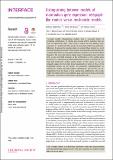Distinguishing between models of mammalian gene expression : telegraph-like models versus mechanistic models
Abstract
Two-state models (telegraph-like models) have a successful history of predicting distributions of cellular and nascent mRNA numbers that can well fit experimental data. These models exclude key rate limiting steps, and hence it is unclear why they are able to accurately predict the number distributions. To answer this question, here we compare these models to a novel stochastic mechanistic model of transcription in mammalian cells that presents a unified description of transcriptional factor, polymerase and mature mRNA dynamics. We show that there is a large region of parameter space where the first, second and third moments of the distributions of the waiting times between two consecutively produced transcripts (nascent or mature) of two-state and mechanistic models exactly match. In this region: (i) one can uniquely express the two-state model parameters in terms of those of the mechanistic model, (ii) the models are practically indistinguishable by comparison of their transcript numbers distributions, and (iii) they are distinguishable from the shape of their waiting time distributions. Our results clarify the relationship between different gene expression models and identify a means to select between them from experimental data.
Citation
Braichenko , S , Holehouse , J & Grima , R 2021 , ' Distinguishing between models of mammalian gene expression : telegraph-like models versus mechanistic models ' , Journal of the Royal Society Interface , vol. 18 , no. 183 , 20210510 . https://doi.org/10.1098/rsif.2021.0510
Publication
Journal of the Royal Society Interface
Status
Peer reviewed
ISSN
1742-5689Type
Journal article
Rights
Copyright © 2021 The Authors. Published by the Royal Society under the terms of the Creative Commons Attribution License http://creativecommons.org/licenses/by/4.0/, which permits unrestricted use, provided the original author and source are credited.
Description
Funding Information: S.B. and R.G. were supported by a Leverhulme Trust grant no. (RPG-2018-423). J.H. was supported by a BBSRC EASTBIO PhD studentship.Collections
Items in the St Andrews Research Repository are protected by copyright, with all rights reserved, unless otherwise indicated.

